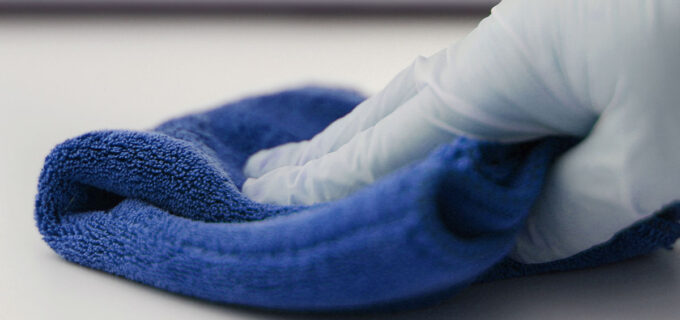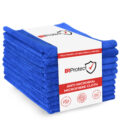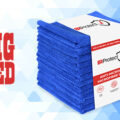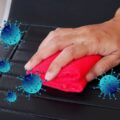Anyone that has actually used the latest generation of microfibre cleaning cloths is well aware that they represent a step-change in efficiency from old fashioned traditional cleaning methods utilising cotton or linen cloths and hot soapy water! The latest microfibre cloths are not only more efficient, and therefore, more hygienic, they are also more economical as there is no need to use large quantities of soap, detergents and other cleaning agents to get things clean and sparkly! Indeed, some premium grade microfibre cloths even go a step further and are impregnated with long-lasting disinfectant agents, these cloths not only leave a surface pristinely clean but also free from microorganisms including harmful bacteria and viruses.
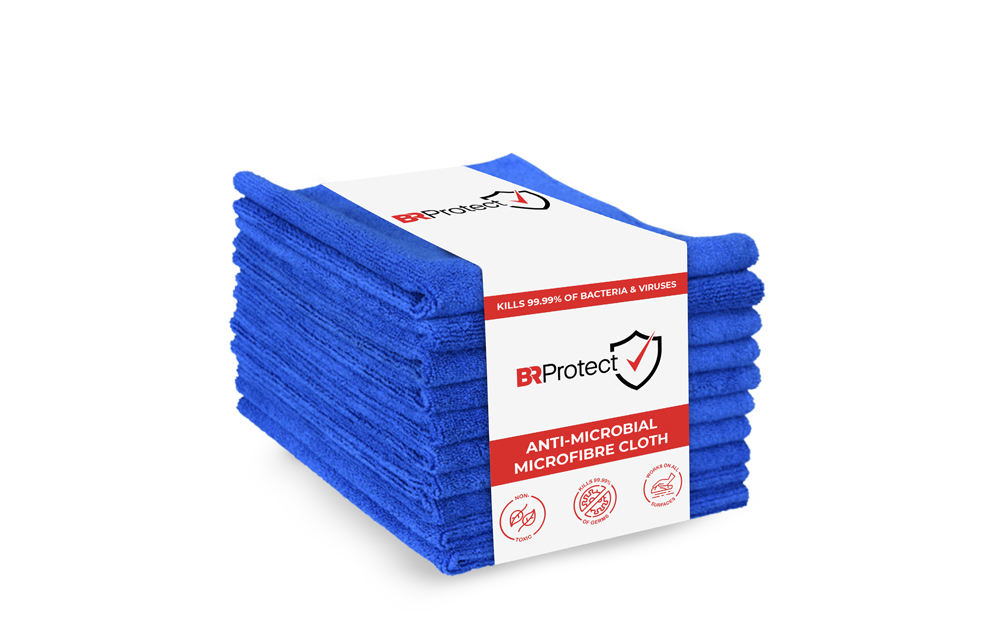
What is a microfibre cleaning cloth?
As the name infers, a ‘microfibre’ cloth is manufactured from a textile fabric that has component fibres so small that they can only be seen with a microscope rather than the naked eye.
How are microfibre cloths made?
Most microfibre cloths are made from a 50:50 blend of polyester and nylon, this blend of two common plastics is heated and forced under great pressure through very small tubes. The extruded fibres are then woven into the fabric of the cloth. The final stage of the manufacturing process causes the fused fibres of polyester and nylon to split apart into microfibres that are 20 to 30 times smaller in diameter than the original extruded fibre. The quality of the cloth is determined by how small the diameter of the final fibres is; the smaller the better.
What are the sizes of the fibres utilised in microfibre cloths?
In a traditional cotton cleaning cloth, the threads are easily seen by the naked eye and are about 0.3mm in diameter or 300microns.
The manufacturers of microfibre cloths will often state that the fibres within their cloths are 100 times smaller in diameter than a human hair! This is not a particularly helpful guide as human hairs can actually vary significantly in size and range from 50 to 200 microns in diameter. Therefore, fibres 100 times smaller the largest diameter human hairs would only fall into the ‘average size’ of microfibre cloths available.
In an ‘average’ microfibre cloth, the fibres will be somewhere between 3 to 5 microns in diameter. To put this in perspective, this is smaller than a grain of pollen at 5 to 10 microns or red blood cells at 10 to 30 microns in diameter. It is also about the same size as most of the ubiquitously found bacteria that are around 1 to 5 microns in diameter. However, these fibre sizes are still much larger than most viruses which are mostly smaller than 0.5 microns in diameter. The best quality microfibre cloths claim their cloth is manufactured from fibres that are 200 times smaller in diameter than a human hair at 0.33 microns. It should be noted that the diameter of the microfibres has a direct bearing on their ability to effectively remove microorganisms including bacteria and viruses.
Why are microfibre cloths more efficient and more hygienic than traditional cloths?
The fibres of a cloth, traditional or microfibre, cannot efficiently remove particles (or microorganisms) that are smaller in diameter than themselves. So traditional cloth fibres which are much, much thicker than microfibres are physically unable to collect and trap microscopic particles of dirt, let alone microorganisms. Conversely, microfibres have the ability to catch and the electrostatically capture microscopic particles that traditional cloths would leave behind. Although the electrostatic charge in an individual microfibre is infinitesimally small, it must be remembered that the overall the cloth contains millions and millions of microfibres so that its ability to ‘magnetically’ attract and capture microscopic dirt particles is greatly magnified. However, even microfibres cannot effectively remove anything smaller in size than their own diameter, therefore, the smaller the fibre the better the cloth will be at removing microscopic debris and microorganisms.

How are microfibre cloths best used?
Unlike traditional cleaning methods that rely on copious amounts of hot water and chemical detergents to dislodge and remove dirt and organic residues, microfibre cloths can be used almost dry, with only a small amount of water or in some cases a sanitising agent to provide the necessary results. Just like a traditional cloth, they are best used dry for dusting, but only slightly moist for general cleaning and sanitation. When using microfibre cloths the need for detergents is almost eliminated. Instead of detergent, the cleaning process depends on the combined electrostatic forces exerted by millions and millions of plastic microfibres to attract and trap microscopic particles of dirt leaving the surface debris free. The particles of dirt then remain electrostatically trapped within the fabric of the cloth until it is washed or laundered.
Can microfibre cloths mechanically trap bacteria and viruses?
Since microfibre cloths cannot effectively attract and trap particles or microorganisms that are smaller than they are, it could be accurate to describe the ‘average’ microfibre cloths as ‘antimicrobial’ or even ‘antibacterial’ unless of course the cloths are used in conjunction with antimicrobial agents which effectively kill the microorganisms on contact. The most potent antimicrobial combination is, of course, a cloth composed of very, very small fibres of no more than 0.3 microns in diameter (which on their own would be able to attract and trap around 99% (2 log kill) of all bacteria and some viral particles) used in conjunction with a broad-spectrum antimicrobial agent which would increase the kill rate to over 99.99% (4 log kill) of all known pathogenic organisms including viruses.
How do you clean and disinfect microfibre cloths after use?
Because microscopic particles of dirt, organic residues and microorganisms remain trapped inside the cloth’s fibres, they need to be cleaned very thoroughly after use. Generally, washing them at very high temperature with a mild detergent causes the fibres to uncurl and release their dirty load. A recent study also determined that the performance of microfibre cloths actually increases with regular laundering.
Related Posts
- How to Dramatically Increase the Antimicrobial Properties of Microfibre Cloths
- BRProtect: A Game-changer in the Fight Against COVID-19
- What are Antimicrobial Coatings?
